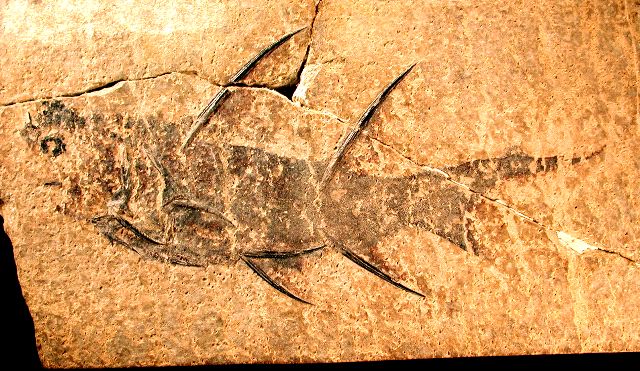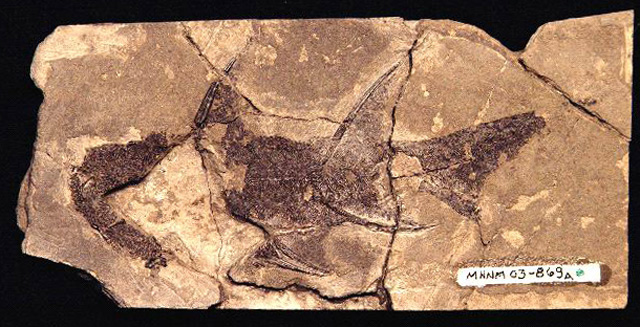Diplacanthus
Of the four known acanthodian species at Miguasha, two are of the same genus and are very similar.
 (52 kb) Diplacanthus horridus and Diplacanthus ellsi both had two large dorsal spines supporting triangular membranous veils. These fins were quite tall with respect to the length of the fish, giving it the distinctive appearance of a caravel, a small 15th century Spanish sailboat.
(52 kb) Diplacanthus horridus and Diplacanthus ellsi both had two large dorsal spines supporting triangular membranous veils. These fins were quite tall with respect to the length of the fish, giving it the distinctive appearance of a caravel, a small 15th century Spanish sailboat.
These two rare species were up to fifteen centimetres long, and sported very pronounced spines with deep grooves along their entire length.
 (96 kb)The name Diplacanthus reflects the fact that the pectoral spine was paired with a small spine on its underbelly.
(96 kb)The name Diplacanthus reflects the fact that the pectoral spine was paired with a small spine on its underbelly.
The two Diplacanthus species at Miguasha were identified based on the appearance of their spines, with the grooves being more numerous and deeper in D. ellsi. This species was only recently named in honour of R. W. Ells, the Geological Survey of Canada geologist who discovered the first specimen during an expedition to Miguasha in 1881.
 (68 kb)
(68 kb)

 (52 kb) Diplacanthus horridus and Diplacanthus ellsi both had two large dorsal spines supporting triangular membranous veils. These fins were quite tall with respect to the length of the fish, giving it the distinctive appearance of a caravel, a small 15th century Spanish sailboat.
(52 kb) Diplacanthus horridus and Diplacanthus ellsi both had two large dorsal spines supporting triangular membranous veils. These fins were quite tall with respect to the length of the fish, giving it the distinctive appearance of a caravel, a small 15th century Spanish sailboat. These two rare species were up to fifteen centimetres long, and sported very pronounced spines with deep grooves along their entire length.

 (96 kb)The name Diplacanthus reflects the fact that the pectoral spine was paired with a small spine on its underbelly.
(96 kb)The name Diplacanthus reflects the fact that the pectoral spine was paired with a small spine on its underbelly. The two Diplacanthus species at Miguasha were identified based on the appearance of their spines, with the grooves being more numerous and deeper in D. ellsi. This species was only recently named in honour of R. W. Ells, the Geological Survey of Canada geologist who discovered the first specimen during an expedition to Miguasha in 1881.

 (68 kb)
(68 kb)Site map | Feedback | Links | Sources | Credits
Diplacanthus
<< Homalacanthus | Actinopterygians >>

Title: Diplacanthus
Author: Illustration by François Miville-Deschênes
Sources: Parc national de Miguasha
Year: 2002
Description:
Diplacanthus, a Miguasha acanthodian.




